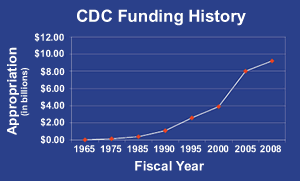State of CDC Archive
Budget and Workforce
The economy of the 21st Century is popularly characterized as a knowledge economy, one in which an organization’s workforce represents its most valuable asset. To that end, a knowledgeable and skilled workforce represents the most critical resource for federal agencies.
2009
The following are some highlights of CDC’s budget and workforce for 2009:
Fiscal Year budget—$10.1 billion. 10,488 government employees and approximately 5,000 contractors of which 72% of staff is located at the Headquarters office in Atlanta, while only 2% are assigned to overseas, with the remaining employees located at our other 11 locations.
168 occupational categories in four key employee occupations— microbiologist, general health scientist, medical officer, and public health program specialist—represent 42.6% of CDC’s workforce.
Approximately half (47.4%) of the workforce has more than 10 years of service. Women account for almost 60% of the workforce, while more than 41% of employees represent minority populations or have a disability. More than half (51%) of employees hold Master or Doctoral Degrees.
2008 Funding by Disease Category

This total includes programs funded by Influenza funding, NCZVED, and NCPDCID, supplemental appropriation from the Public Health and Social Services & Emergency Fund.
** This total includes VFC, Section 317 and Immunization program operations.
*** Includes Public Health Research , Public Health Improvement& Leadership, Preventive Health & Health Services Block Grant, Buildings & Facilities, Business Services Support, Health Information & Service, and User Fees.
| Disease | Percentage of Funding |
|---|---|
| Infectious Disease Control | 4% |
| HIV/AIDS,STD, and TB Prevention | 11% |
| Immunization | 36% |
| Chronic Disease Precention, Health Promotion, and Genomics | 9% |
| Birth Defects, Developmental Disabilities, Disability & Health | 1% |
| Environmental Health | 2% |
| Injury Prevention and Control | 1% |
| Occupational Safety and Health | 4% |
| Global Health | 3% |
| Terrorism | 16% |
| Agency for Toxic Substances and Disease Registry | 1% |
| Other | 12% |
2008
Workforce

As the scope and breadth of CDC activities have grown, so has the workforce. With employees now working in 173 occupational series, CDC’s reputation as the most reputable source of public health information is attributed to the outstanding dedication of its talented workforce. Staff have been on the front lines of health prevention, often serving as the first responders to health threats around the world, since CDC’s inception.
The CDC Workforce at a Glance
- Women make up 61% of the workforce.
- Disabled members constitute 7% the workforce.
- Employees of a minority race and/or national origin make up 37% of the workforce.
- More than 80% hold a bachelors degree or higher; nearly 50% have advanced degrees.
- There were 70 countries represented among fiscal year 2008 scientific fellowships applicants.
- Staff earned more than 40,994 continuing education and continuing medical education credits.
The majority of CDC employees work out of the Atlanta, Georgia, headquarters, however the agency has a major presence in nine other US cities and in numerous countries around the globe:
 |
|
Fiscal Year 2008 Snapshot

In an era of limited fiscal resources and many competing priorities, CDC is committed to leveraging resources to achieve maximum health results and reduce health disparities. As new health threats emerged, CDC’s mission expanded and its funding continued to increase. Prioritizing the agency’s activities within the four overarching Health Protection Goals ensures the focus remains on optimizing health impact in every laboratory on our campus, in every program funded, in all health protection research, and in every outbreak CDC and its partners contain.
The FY 2008 CDC/ATSDR budget of $9.2 billion reflects an increase of approximately $100 million above the FY 2007 Appropriation level. The FY 2008 budget for CDC addressed a balanced portfolio of health protection activities, emphasizing preparation for the urgent threats of today and those anticipated in the future. This dual emphasis reflects CDC’s complex mission in the twenty-first century—to protect the public’s health against major calamities such as pandemic influenza, natural disasters, and terrorism—while remaining focused on the threats to health and well-being that Americans face each day, including chronic diseases, injuries, and disabilities.
2008 Funding by Disease Category
- 36% - Immunization **
- 16% - Terrorism
- 12% - Other ***
- 11% - HIV/AIDS, STD, and TB Prevention
- 9% - Chronic Diseases Prevention, Health Promotion, and Genomics
- 4% - Infectious Disease Control *
- 4% - Occupational Safety & Health
- 3% - Global Health
- 2% - Environmental Health
- 1% - Agency for Toxic Substance & Disease Registry
- 1% - Birth Defects, Developmental Disabilities, Disability & Health
- 1% - Injury Prevention & Control
2007
Fiscal Year 2007 Budget
In an era of limited fiscal resources and many competing priorities, CDC is committed to leveraging resources to achieve maximum health results and reduce health disparities. Prioritizing the agency′s activities within the four overarching Health Protection Goals ensures that we are focused on optimizing health impact in every laboratory on our campus, in every program we fund, in all our health protection research, and in every outbreak we contain.
Our focus on strategic excellence and innovation is illustrated by the incredible progress we have made in 2007 on “Health Impact Planning” for CDC. CDC now has available a robust Web-based tool that pulls together much of the agency′s strategy information, including alignment to the Health Protection Goals, budget, and procurement information at the project level. We are also taking on some tough policy issues, including looking at the future of our role in immunizations and exploring how we can better leverage external spending to create societal change around some of our best science (e.g., health associated with tobacco). We have started work on founding a new virtual “Policy Academy” to help mentor and support CDC′s commitment to health policy analysis. We are especially excited about the work we have done in the past year to achieve organizational excellence, as showcased by the following:
- Received the highest rating on Improved Financial Performance as part of the President′s Management Agenda
- Implemented the Vaccine Management Business Improvement Project that will lead to more efficient distribution of vaccine directly to providers and clinics
- Enhanced financial reporting system to speed up our reporting capability and provide us with tools to better determine fiscal needs for the next year
- Created a business services improvement office to increase the effectiveness of business activities at CDC
- Targeted communication and media activities to successfully raise awareness about such health concerns as chronic fatigue syndrome, multidrug resistant Staphylococcus, foodborne illnesses, and multidrug resistant tuberculosis
In the coming fiscal year, CDC will continue to lead in promoting health among young people and adults, across all life stages, and in schools and communities around the country. With sustained focus and continued investment, we will continue to be prepared for the next public health emergency, we will begin to roll back the impact of a sedentary lifestyle and stop the spread of HIV/AIDS, and we will work with partners at home and abroad to ensure a healthy national and international community.
| Disease | Funding |
|---|---|
| Immunization | $3,420 |
| Terrorism | $1,479 |
| CDC-Wide HIV/AIDS | $880 |
| Occupational Safety and Health | $315 |
| Cancer Prevention and Control | $301 |
| Secually Transmitted Diseases | $155 |
| Environmental Health | $147 |
| Tuberculosis | $135 |
| Tobacco | $102 |
| Intentional Injury | $102 |
| Polio Eradication | $100 |
| Pandemic Influenza Supplementals | $70 |
| Diabetes | $62 |
| Heart Disease and Stroke | $44 |
| Measles (and others) | $43 |
| Nutrition, Physical Activity and Obesity | $41 |
| Childhood Lead Poisoning | $35 |
| Unintentional Injury | $34 |
| West Nile Virus | $27 |
| Global Malaria Program | $9 |
Contact Us:
- Centers for Disease Control and Prevention
1600 Clifton Rd
Atlanta, GA 30333 - 800-CDC-INFO
(800-232-4636)
TTY: (888) 232-6348 - Contact CDC–INFO


